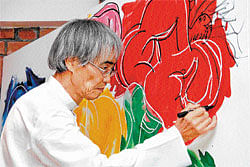“I was on a boat floating on the sacred Ganges, watching the countless tiny offerings of flowers and fire on the surface of the water, blooming, shimmering as they drift by.
Suddenly, I experienced a vision. My head was full of glittering golden particles, a flood of form came down to me like a shower.
Amongst all that, I envisioned the face of Lakshmi, merging with the earth and plants, blooming from the root of a huge tree.”

Nobu Yatsugi looked up from the paper he was reading from to meet the eyes of his audience. At this instance, it was easier for him to say who exactly had understood the poem he had just read out in Japanese, and who amongst the audience were looking eagerly to have someone interpret the words for them in English. Even for them, it wasn’t difficult to observe the palpable feeling of elation and joy in the face of this rather diminutive giant, whose creative product was the focus of admiration for everyone gathered at the place there on that warm Sunday afternoon.
“India inspires me. It certainly stirs the imagination of an artist. Nowhere in the world can you feel such high levels of spiritual energy and creative force,” he later said, fondly looking at the statue he had made out of iron and bronze.
“That’s a gift I am leaving for India and the incredible people here,” he said, pointing at the colourful statue with patterns of lotus flowers, roots and dancing fairies.
Yatsugi is one of the many top artists from Japan who have started to look towards India, in recent times, as floundering economy, depleting pension funds and the looming threat of natural and nuclear disasters post-Fukushima have introduced fresh uncertainties in the society.
In terms of opportunity, artists can only turn to China and India, the “Asian giants” whose growing economies create newer opportunities for them. India’s ability to offer the rare blend of spiritual solace and creative opportunity seems harder to resist for many Japanese artists. They feel at home in India. For generations, the firmament of Hindu gods and goddesses has fired their imagination and respect, not to mention the amazement of Indians as “those who invented the zero”.
Wandering fairy
For Yatsugi, one of the top 10 artists of Japan, India’s spiritual energy and creative potency are the major attractions. After learning painting from Sanya Nakade, he set out to Paris in 1977.
“I worked there for sometime and went on to live in New York, though that doesn’t leave me any better in English,” he laughs. “It was like a period of absorption. I was evolving as an artist and, gradually, fashioning statues out of iron and bronze became my speciality.”
In 1984, Yatsugi was busy setting up his studio in Kannami town (Shizuoka prefecture). Indeed Shizuoka, located in the foothills of Mount Fuji, became the hub for many artists in Japan after the war and it was little wonder that Yatsugi wanted to settle there.
His work has since brought him several awards and recognitions — such as the prestigious TV Yamaguchi Award, given to 12 contemporary Japanese artists, and the 156th Nagano Open Air Sculpture Prize (in 1988), that confirmed his position as one of his country’s pre-eminent artistic figures.
“I always wanted to visit India and collaborate with local artists here,” he says, pointing to the fact that the sculpture nestled in the corner of the new building was made entirely with the help of local artisans in Bangalore.
“Like Tenshin Okakura, who believed in the ability of Asian art to inter-connect, I believe there is a lot of room in our respective creative traditions to collaborate… That is what I wanted to do.”
In fact, Yatsugi’s visit to India was in serious doubt when he had a fall while working and was confined to a wheelchair.
“I arrived in India on a wheelchair. I never believed I would be in a position to accomplish what I wanted — interacting with local artists and exploring possible collaborative works. But I spent time in an ashram on the outskirts of Bangalore where the air was pure and the food, healthy. My body mended and I healed faster,” he recalls.
Fully fit, he traversed the land of his spiritual dreams, meeting village artists and exchanging ideas with them. It was at Varanasi that he actually felt the energy he describes in the poem.
“I was oblivious to the mass of mankind that surrounded me. I felt strangely drawn to some invisible power which brought that vision I had replicated in my work here. There’s certainly a sense of purity to the land and the people here. The economic buzz has done little to destroy the millennia-old culture.”
Yatsugi’s work sits in a quiet corner of Koramangala, created with the view of promoting a dialogue between local artists and collecting artistic books in local languages. He is happy that the product of his Indian collaboration has found the right place. “I’d like to come back and live here,” Yatsugi declares.